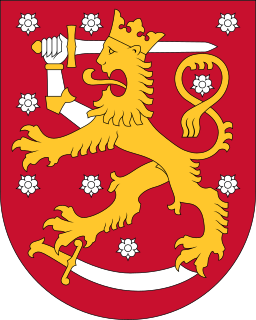
The politics of Finland take place within the framework of a parliamentary representative democracy. Finland is a republic whose head of state is President Sauli Niinistö, who leads the nation's foreign policy and is the supreme commander of the Finnish Defence Forces. Finland's head of government is Prime Minister Sanna Marin, who leads the nation's executive branch, called the Finnish Government. Legislative power is vested in the Parliament of Finland, and the Government has limited rights to amend or extend legislation. Because the Constitution of Finland vests power to both the President and Government, the President has veto power over parliamentary decisions, although this power can be overruled by a majority vote in the Parliament.

Kyösti Kallio was a Finnish politician of the Agrarian League who served as the fourth president of Finland from 1937–1940. He was the first President of Finland to resign and the only president to die in office.
The Green League, shortened to the Greens, is a green political party in Finland.
The Swedish People's Party of Finland is a political party in Finland aiming to represent the interests of the minority Swedish-speaking population of Finland. The party is currently participating in the government of Sanna Marin, holding the positions of Minister of Justice and Minister for Nordic Cooperation and Equality.

The Left Alliance is a left-wing political party in Finland.
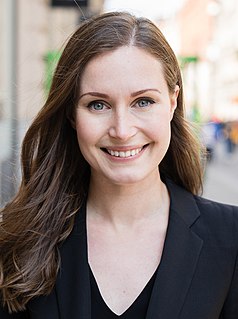
The prime minister of Finland is the head of the Finnish Government. The prime minister is Finland's head of government and is formally ranked third in the protocol after the president of Finland and the speaker of the Parliament. Finland's first prime minister was Pehr Evind Svinhufvud, was appointed on 27 November 1917, just a few days before the country became independent.
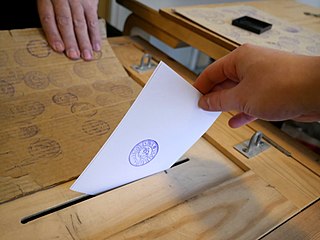
There are four types of elections in Finland. Each Finnish citizen at least 18 years of age has the right to vote in each of the elections, which decide the following: the president, the parliament, the MEPs, and the municipal and city councils.
A minister is a politician who heads a ministry, making and implementing decisions on policies in conjunction with the other ministers. In some jurisdictions the head of government is also a minister and is designated the ‘prime minister’, ‘premier’, ‘chief minister’, ‘chancellor’ or other title.
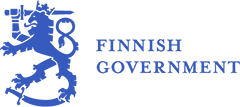
The Finnish Government is the executive branch and cabinet of Finland, which directs the politics of Finland and is the main source of legislation proposed to the Parliament. The Government has collective ministerial responsibility and represents Finland in the Council of the European Union. In the incumbent Marin Cabinet, the Government comprises 19 ministers leading 12 ministries.
The Minister for Foreign Affairs handles the Finnish Government's foreign policy and relations, and is in charge of the Ministry for Foreign Affairs. The Minister for Foreign Trade and Development is also associated with this ministry.

Ahti Kalle Samuli Karjalainen was a Finnish politician. He was a member of the Agrarian League and served two terms as Prime Minister of Finland. He is, however, better known for his period as Minister of Foreign Affairs of Finland. Karjalainen is considered one of the most influential figures in post-war Finnish politics. Like President Urho Kekkonen, Karjalainen attached great importance to Finland's relationship with the Soviet Union.

The first cabinet of Paavo Lipponen was the 66th government of Finland, which existed from 13 April 1995 to 15 April 1999. The cabinet’s Prime Minister was Paavo Lipponen. It was a majority government, and one of the longest-running governments in Finnish history. Lipponen's first government ran for a whole term of a Finnish cabinet, or 1 464 days in total. The cabinet was composed of a coalition formed by the Social Democratic Party, the National Coalition Party, the Swedish People's Party, the Left Alliance, and the Green League. Due to the cabinet containing five separate parties from all over Finland's political spectrum, both of Lipponen's cabinets were considered rainbow coalitions.
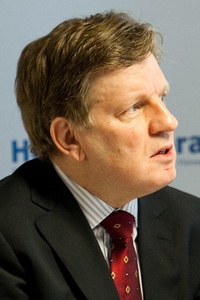
The cabinet of Esko Aho was the 65th government of Finland. The cabinet existed from 26 April 1991 to 13 April 1995. The cabinet’s Prime Minister was Esko Aho.
Lauri Ingman's second cabinet was the 11th Government of independent Finland, serving between 31 May 1924 – 31 March 1925. It was formed following the 1924 parliamentary elections between four parties—National Coalition Party, Agrarian Party, National Progressive Party and Swedish People's Party—and had a majority in the parliament during the first six months. Overall, the cabinet lasted 305 days in office.

A cabinet is a body of high-ranking state officials, typically consisting of the executive branch's top leaders. Members of a cabinet are usually called cabinet ministers or secretaries. The function of a cabinet varies: in some countries, it is a collegiate decision-making body with collective responsibility, while in others it may function either as a purely advisory body or an assisting institution to a decision-making head of state or head of government. Cabinets are typically the body responsible for the day-to-day management of the government and response to sudden events, whereas the legislative and judicial branches work in a measured pace, in sessions according to lengthy procedures.

The Social Democratic Party of Finland, shortened to the Social Democrats and commonly known in Finnish as Demarit, is a social-democratic political party in Finland. It is currently the largest party in the Parliament of Finland with 40 seats.

The cabinet of Juha Sipilä was the 74th government of Finland. It was formed following the parliamentary election of 2015 and formally appointed by President Sauli Niinistö on 29 May 2015. Since June 2017, the cabinet has consisted of a coalition formed by the Centre Party, Blue Reform and the National Coalition Party. The cabinet's Prime Minister was Juha Sipilä.
Paasio's first cabinet was the 50th government of Finland, which lasted from 27 May 1966 to 22 March 1968. It was a majority government based on the popular front model. The cabinet’s Prime Minister was Rafael Paasio.
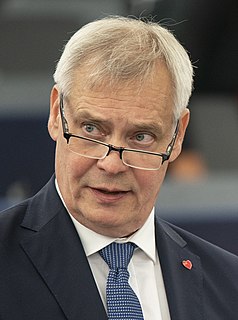
The cabinet of Antti Rinne was the 75th government of Finland. It was formed following the parliamentary election of 2019 and was formally appointed by President Sauli Niinistö on 6 June 2019. The cabinet consisted of a coalition formed by the Social Democratic Party, the Centre Party, the Green League, the Left Alliance, and the Swedish People's Party. The cabinet's Prime Minister was Antti Rinne.
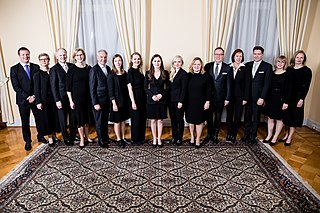
The cabinet of Sanna Marin is the incumbent 76th government of Finland. It was formed following the collapse of the Rinne Cabinet and officially took office on 10 December 2019. The cabinet consists of a coalition formed by the Social Democratic Party, the Centre Party, the Green League, the Left Alliance, and the Swedish People's Party.















